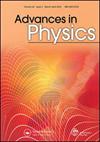Statistical models of fracture
IF 13.8
1区 物理与天体物理
Q1 PHYSICS, CONDENSED MATTER
引用次数: 279
Abstract
Disorder and long-range interactions are two of the key components that make material failure an interesting playfield for the application of statistical mechanics. The cornerstone in this respect has been lattice models of the fracture in which a network of elastic beams, bonds, or electrical fuses with random failure thresholds are subject to an increasing external load. These models describe on a qualitative level the failure processes of real, brittle, or quasi-brittle materials. This has been particularly important in solving the classical engineering problems of material strength: the size dependence of maximum stress and its sample-to-sample statistical fluctuations. At the same time, lattice models pose many new fundamental questions in statistical physics, such as the relation between fracture and phase transitions. Experimental results point out to the existence of an intriguing crackling noise in the acoustic emission and of self-affine fractals in the crack surface morphology. Recent advances in computer power have enabled considerable progress in the understanding of such models. Among these partly still controversial issues, are the scaling and size-effects in material strength and accumulated damage, the statistics of avalanches or bursts of microfailures, and the morphology of the crack surface. Here we present an overview of the results obtained with lattice models for fracture, highlighting the relations with statistical physics theories and more conventional fracture mechanics approaches. Contents PAGE 1. Introduction 351 2. Elements of fracture mechanics 354 2.1. Theory of linear elasticity 354 2.2. Cracks in elastic media 355 2.3. The role of disorder on material strength 357 2.4. Extreme statistics for independent cracks 359 2.5. Interacting cracks and damage mechanics 360 2.6. Fracture mechanics of rough cracks 363 2.6.1. Crack dynamics in a disordered environment: self-affinity and anomalous scaling 363 2.6.2. Crack roughness and fracture energy 366 3. Experimental background 368 3.1. Strength distributions and size-effects 368 3.2. Rough cracks 371 3.3. Acoustic emission and avalanches 379 3.4. Time-dependent fracture and plasticity 385 4. Statistical models of failure 386 4.1. Random fuse networks: brittle and plastic 386 4.2. Tensorial models 391 4.3. Discrete lattice versus finite element modeling of fracture 393 4.4. Dynamic effects 397 4.4.1. Annealed disorder and other thermal effects 397 4.4.2. Sound waves and viscoelasticity 398 4.5. Atomistic simulations 401 5. Statistical theories for fracture models 402 5.1. Fiber bundle models 402 5.1.1. Equal load sharing fiber bundle models 403 5.1.2. Local load sharing fiber bundle models 405 5.1.3. Generalizations of fiber bundle models 406 5.2. Statistical mechanics of cracks: fracture as a phase transition 408 5.2.1. Generalities on phase transitions 409 5.2.2. Disorder induced non-equilibrium phase transitions 411 5.2.3. Phase transitions in fracture models 413 5.3. Crack depinning 415 5.4. Percolation and fracture 417 5.4.1. Percolation scaling 417 5.4.2. Variations of the percolation problem 419 5.4.3. Strength of diluted lattices 420 5.4.4. Crack fronts and gradient percolation 422 6. Numerical simulations 424 6.1. The I–V characteristics and the damage variable 425 6.2. Damage distribution 430 6.2.1. Scaling of damage density 432 6.2.2. Damage localization 435 6.2.3. Crack clusters and damage correlations 437 6.3. Fracture strength 440 6.3.1. The fracture strength distribution 440 6.3.2. Size effects 443 6.3.3. Strength of notched specimens 445 6.4. Crack roughness 447 6.5. Avalanches 450 7. Discussion and outlook 454 7.1. Strength distribution and size-effects 455 7.2. Morphology of the fracture surface: roughness exponents 456 7.3. Crack dynamics: avalanches and acoustic emission 457 7.4. From discrete models to damage mechanics 458 7.5. Concluding remarks and perspectives 458 Acknowledgments 459 Appendix A: Algorithms 459 References 468断裂统计模型
无序和远程相互作用是使材料失效成为统计力学应用领域的两个关键组成部分。这方面的基础是断裂的晶格模型,其中弹性梁、键或具有随机失效阈值的保险丝网络受到不断增加的外部负载的影响。这些模型在定性层面上描述了真实、脆性或准脆性材料的破坏过程。这对于解决材料强度的经典工程问题尤其重要:最大应力的尺寸依赖性及其样本间的统计波动。同时,点阵模型在统计物理中提出了许多新的基本问题,如断裂与相变之间的关系。实验结果表明声发射中存在一种有趣的裂纹噪声,裂纹表面形貌中存在自仿射分形。计算机能力的最新进步使得对这些模型的理解取得了相当大的进展。在这些部分仍有争议的问题中,包括材料强度和累积损伤的尺度和尺寸效应,雪崩或微破坏爆发的统计数据,以及裂纹表面的形态。在这里,我们概述了用裂缝晶格模型获得的结果,强调了与统计物理理论和更传统的断裂力学方法的关系。第1页。2.引言断裂力学要素354线弹性理论354 2.2。弹性介质中的裂纹355无序度对材料强度的影响独立裂缝的极端统计量359 2.5。相互作用裂纹和损伤力学360 2.6。粗裂纹断裂力学363 2.6.1。无序环境中的裂纹动力学:自亲和和异常尺度363 2.6.2。裂纹粗糙度和断裂能366实验背景3683.2.强度分布和尺寸效应粗糙裂纹371 3.3。声发射和雪崩时间相关断裂与塑性[j]。失败的统计模型386。随机保险丝网络:脆性和塑性386 4.2。张量模型391裂缝的离散点阵与有限元建模动态效果397 4.4.1。退火无序和其他热效应。声波与粘弹性398原子模拟断裂模型的统计理论402光纤束模型402 5.1.1。等负荷分担光纤束模型403 5.1.2。本地负载共享光纤束模型405 5.1.3。纤维束模型的概括裂纹的统计力学:作为相变的断裂[8]5.2.1。关于相变的概论。无序引起非平衡相变。裂缝模型中的相变裂纹剥落415 5.4。5.4.1.渗漏与破裂渗透垢417 5.4.2。渗透问题的变体419 5.4.3稀释格的强度420 5.4.4。裂缝前缘和梯度渗流[22]1.数值模拟I-V特性和损伤变量425 6.2。伤害分布430 6.2.1。缩放伤害密度432 6.2.2。6.2.3.损伤定位裂纹簇和损伤关联437 6.3。断裂强度440 6.3.1。断裂强度分布440 6.3.2。尺寸效果443 6.3.3。缺口试件强度445 6.4。裂纹粗糙度447 6.5。雪崩450讨论与展望强度分布和尺寸效应断口形貌:粗糙度指数456 7.3。裂纹动力学:雪崩和声发射457 7.4。从离散模型到损伤力学。结束语和观点致谢附录A:算法参考文献
本文章由计算机程序翻译,如有差异,请以英文原文为准。
求助全文
约1分钟内获得全文
求助全文
来源期刊

Advances in Physics
物理-物理:凝聚态物理
CiteScore
67.60
自引率
0.00%
发文量
1
期刊介绍:
Advances in Physics publishes authoritative critical reviews by experts on topics of interest and importance to condensed matter physicists. It is intended for motivated readers with a basic knowledge of the journal’s field and aims to draw out the salient points of a reviewed subject from the perspective of the author. The journal''s scope includes condensed matter physics and statistical mechanics: broadly defined to include the overlap with quantum information, cold atoms, soft matter physics and biophysics. Readership: Physicists, materials scientists and physical chemists in universities, industry and research institutes.
 求助内容:
求助内容: 应助结果提醒方式:
应助结果提醒方式:


